Interface Joint Strength between SS316L Wrought Substrate and Powder Bed Fusion Built Parts
Abstract
:1. Introduction
2. Materials and Methods
- Pull rate of 2 in/min
- Data acquisition at 10 Hz
- Measured: elongation (in) vs tensile load (lb)
- Rotation rate of 6°/min
- Rotation range of 90°
- Data acquisition at 10 Hz
- Measured: rotation (deg) vs. torque load (lb-in)
3. Results
3.1. Tensile Testing
3.2. Torsional Testing
3.3. Microscopy
4. Discussion
4.1. Analysis of Wrought and PBF AM Specimens
4.2. Analysis of Hybrid PBF/Wrought Specimens
5. Conclusions
- Hybrid PBF/wrought tensile failures occurred well away from the bond interface, in the wrought portion of the specimen, demonstrating that the interface bond quality was good. The torsion specimens also showed concentrated deformation in the wrought portion of each specimen.
- The yield and ultimate tensile strengths of the SS316L PBF material were significantly greater than that of the wrought material of the same alloy (550 and 680 MPa for the PBF material, compared to 320 and 530 MPa for the wrought material).
- Average grain sizes for the SS316L PBF material were 48 µm versus 60 µm for the wrought material. The Hall–Petch effect, which is pronounced in SS316L, is likely the reason for the greater strength of the PBF material and explains the behavior of the hybrid PBF/wrought specimens in uniaxial tension and torsion.
Author Contributions
Funding
Institutional Review Board Statement
Informed Consent Statement
Data Availability Statement
Acknowledgments
Conflicts of Interest
Nomenclature
| AM | Additive Manufacturing |
| DED | Directed Energy Deposition |
| EBSD | Electron Backscatter Diffraction |
| EDM | Electrical Discharge Machining |
| PBF | Powder Bed Fusion |
References
- Frazier, W.E. Metal Additive Manufacturing: A Review. J. Mater. Eng. Perform. 2014, 23, 1917–1928. [Google Scholar] [CrossRef]
- Everton, S.K.; Hirsch, M.; Stravroulakis, P.; Leach, R.K.; Clare, A.T. Review of In-Situ Process Monitoring and In-Situ Metrology for Metal Additive Manufacturing. Mater. Des. 2016, 95, 431–445. [Google Scholar] [CrossRef]
- Mandil, G.; Le, V.T.; Paris, H. Building New Entities from Existing Titanium Part by Electron Beam Melting: Microstructures and Mechanical Properties. Int. J. Adv. Manuf. Technol. 2016, 85, 1835–1846. [Google Scholar] [CrossRef] [Green Version]
- Vartanian, K.; McDonald, T. Accelerating Industrial Adoption of Metal Additive Manufacturing Technology. JOM 2016, 68, 806–810. [Google Scholar] [CrossRef]
- Pragana, J.P.M.; Sampaio, R.F.V.; Bragança, I.M.F.; Silva, C.M.A.; Martins, P.A.F. Hybrid metal additive manufacturing: A state–of–the-art review. Adv. Ind. Manuf. Eng. 2021, 2, 100032. [Google Scholar] [CrossRef]
- Gebisa, A.W.; Lemu, H.G. Additive Manufacturing for the Manufacture of Gas Turbine Engine Components: Literature Review and Future Perspectives. In Proceedings of the ASME Turbo Expo 2018: Turbomachinery Technical Conference and Exposition, Oslo, Norway, 11–15 June 2018. [Google Scholar]
- Vendra, L.; Achanta, A. Metal Additive Manufacturing in the Oil and Gas Industry. In Proceedings of the Solid Freeform Fabrication 2018: Proceedings of the 29th Annual Solid Freeform Fabrication Symposium, Austin, TX, USA, 13–15 August 2018. [Google Scholar]
- Sireesha, M.; Lee, J.; Kranthi Kiran, A.S.; Babu, V.J.; Kee, B.B.T.; Ramakrishna, S. A review on additive manufacturing and its way into the oil and gas industry. RSC Adv. 2018, 8, 22460–22468. [Google Scholar] [CrossRef] [Green Version]
- Vayre, B.; Vignat, F.; Villeneuve, F. Designing for Additive Manufacturing. Procedia Cirp 2012, 3, 632–637. [Google Scholar] [CrossRef] [Green Version]
- Azizi, H.; Ghiaasiaan, R.; Prager, R.; Ghoncheh, M.H.; Samk, K.A.; Lausic, A.; Byleveld, W.; Phillion, A.B. Metallurgical and mechanical assessment of hybrid additively-manufactured maraging tool steels via selective laser melting. Addit. Manuf. 2019, 27, 389–397. [Google Scholar] [CrossRef]
- Jones, J. Repurposing Mainstream CNC Machine Tools for Laser-Based Additive Manufacturing. In Proceedings of the SPIE LASE, San Fransisco, CA, USA, 6 April 2016; Volume 9738. [Google Scholar]
- Onuike, B.; Bandyopadhyay, A. Additive manufacturing in repair: Influence of processing parameters on properties of Inconel 718. Mater. Lett. 2019, 252, 256–259. [Google Scholar] [CrossRef]
- Jones, J.; McNutt, P.; Tosi, R.; Perry, C.; Wimpenny, D. Remanufacture of turbine blades by laser cladding, machining and in-process scanning in a single machine. In Proceedings of the 23rd Annual International Solid Freeform Fabrication Symposium, Austin, TX, USA, 6–8 August 2012; pp. 821–827. [Google Scholar]
- Praniewicz, M.; Kurfess, T.; Saldana, C. Adaptive geometry transformation and repair for hybrid manufacturing. Procedia Manuf. 2018, 26, 228–236. [Google Scholar] [CrossRef]
- Mudge, R.P.; Wald, N.R. Laser engineered net shaping advances additive manufacturing and repair. Weld. J. N. Y. 2007, 86, 44. [Google Scholar]
- Popov, V.V.; Fleisher, A. Hybrid additive manufacturing of steels and alloys. Manuf. Rev. 2020, 7, 6. [Google Scholar] [CrossRef] [Green Version]
- Le, V.T.; Paris, H.; Mandil, G. Extracting features for manufacture of parts from existing components based on combining additive and subtractive technologies. Int. J. Interact. Des. Manuf. 2018, 12, 525–536. [Google Scholar] [CrossRef]
- Zhao, G.; Ma, G.; Feng, J.; Xiao, W. Nonplanar slicing and path generation methods for robotic additive manufacturing. Int. J. Adv. Manuf. Technol. 2018, 96, 3149–3159. [Google Scholar] [CrossRef]
- Zhang, Y.; Jarosinski, W.; Jung, Y.-G.; Zhang, J. 2—Additive manufacturing processes and equipment. In Additive Manufacturing: Materials, Processes, Quantifications and Applications; Zhang, J., Jung, Y.-G., Eds.; Butterworth-Heinemann: Oxford, UK, 2018; pp. 39–51. [Google Scholar] [CrossRef]
- Gibson, I.; Rosen, D.; Stucker, B. Powder Bed Fusion Processes. In Additive Manufacturing Technologies; Springer: New York, NY, USA, 2015. [Google Scholar] [CrossRef]
- Tan, C.; Zhou, K.; Ma, W.; Min, L. Interfacial characteristic and mechanical performance of maraging steel-copper functional bimetal produced by selective laser melting based hybrid manufacture. Mater. Des. 2018, 155, 77–85. [Google Scholar] [CrossRef]
- Dolev, O.; Osovski, S.; Shirizly, A. Ti-6Al-4V hybrid structure mechanical properties—Wrought and additive manufactured powder-bed material. Addit. Manuf. 2021, 37, 101657. [Google Scholar] [CrossRef]
- Shakerin, S.; Hadadzadeh, A.; Amirkhiz, B.S.; Shamsdini, S.; Li, J.; Mohammadi, M. Additive manufacturing of maraging steel-H13 bimetals using laser powder bed fusion technique. Addit. Manuf. 2019, 29, 100797. [Google Scholar] [CrossRef]
- ASTM E8/E8M-16ae1. Standard Test Methods for Tension Testing of Metallic Materials; ASTM International: West Conshohocken, PA, USA, 2016. [Google Scholar]
- A240/A240M-20a Standard Specification for Chromium and Chromium-Nickel Stainless Steel Plate, Sheet, and Strip for Pressure Vessels and for General Applications; ASTM International: West Conshohocken, PA, USA, 2020. [CrossRef]
- Specification Sheet: Alloy 316/316L. Available online: https://www.sandmeyersteel.com/images/316-316l-317l-spec-sheet.pdf (accessed on 11 January 2021).
- Qin, W.; Li, J.; Liu, Y.; Kang, J.; Zhu, L.; Shu, D.; Peng, P.; She, D.; Meng, D.; Li, Y. Effects of grain size on tensile property and fracture morphology of 316L stainless steel. Mater. Lett. 2019, 254, 116–119. [Google Scholar] [CrossRef]
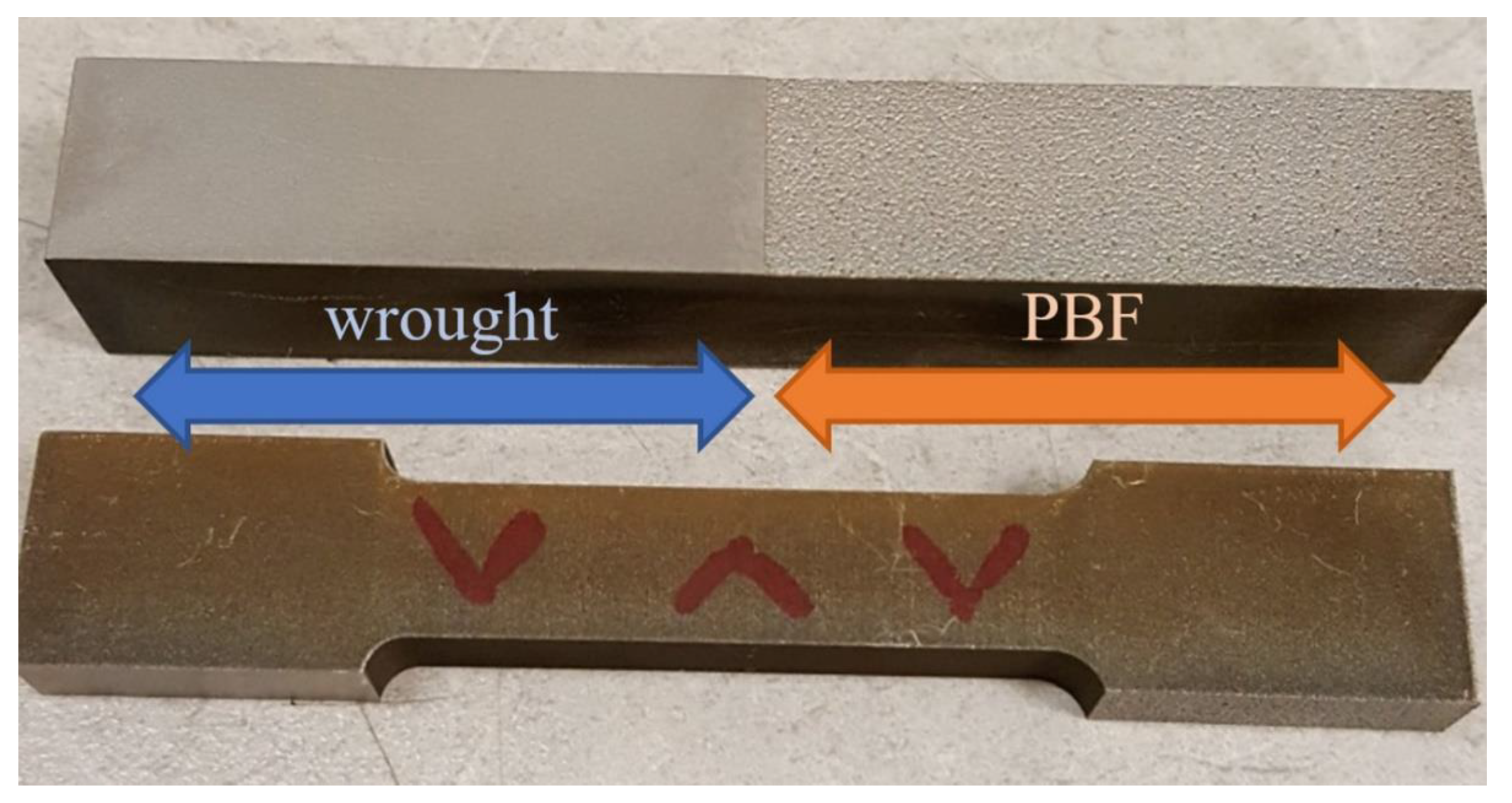

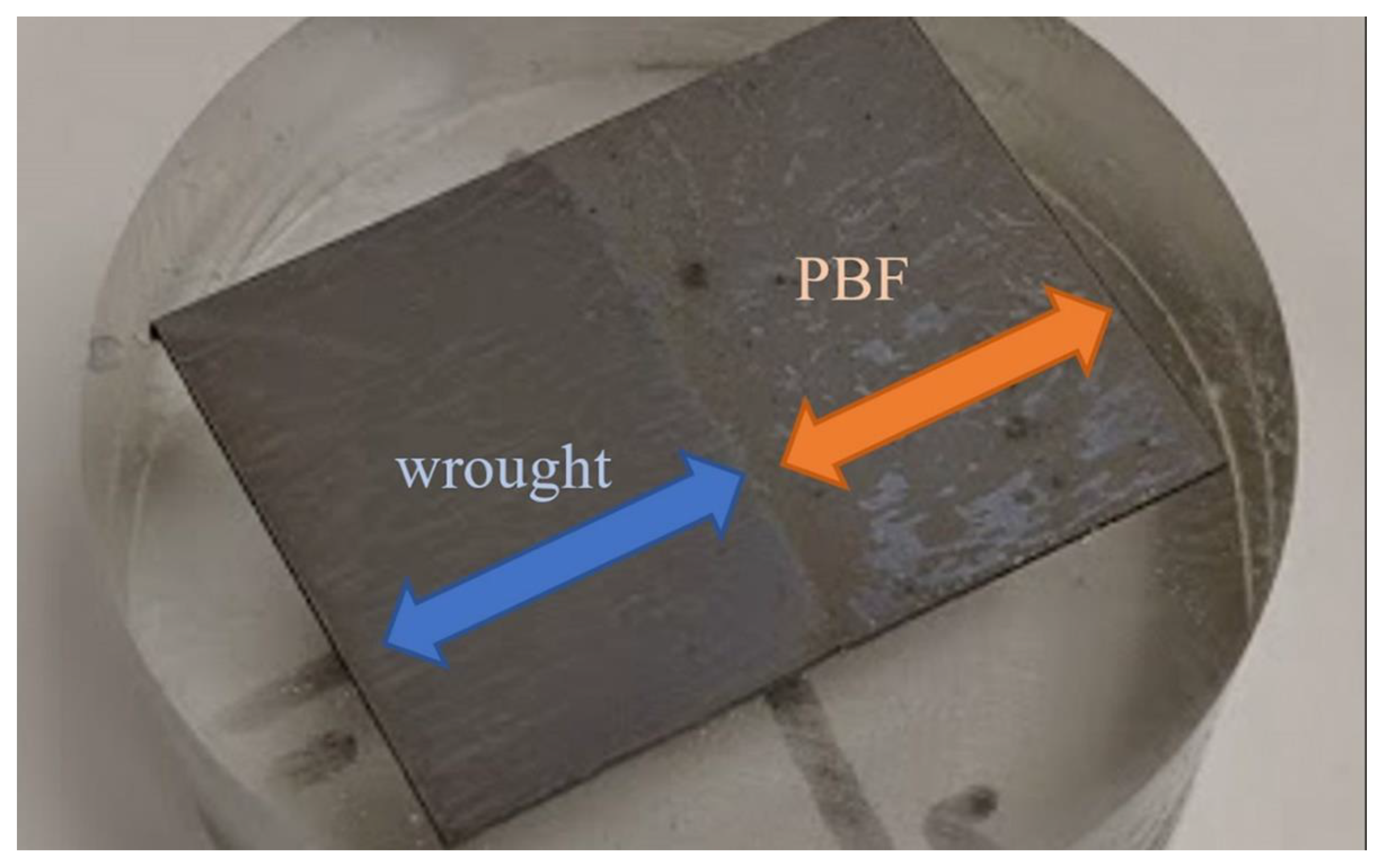
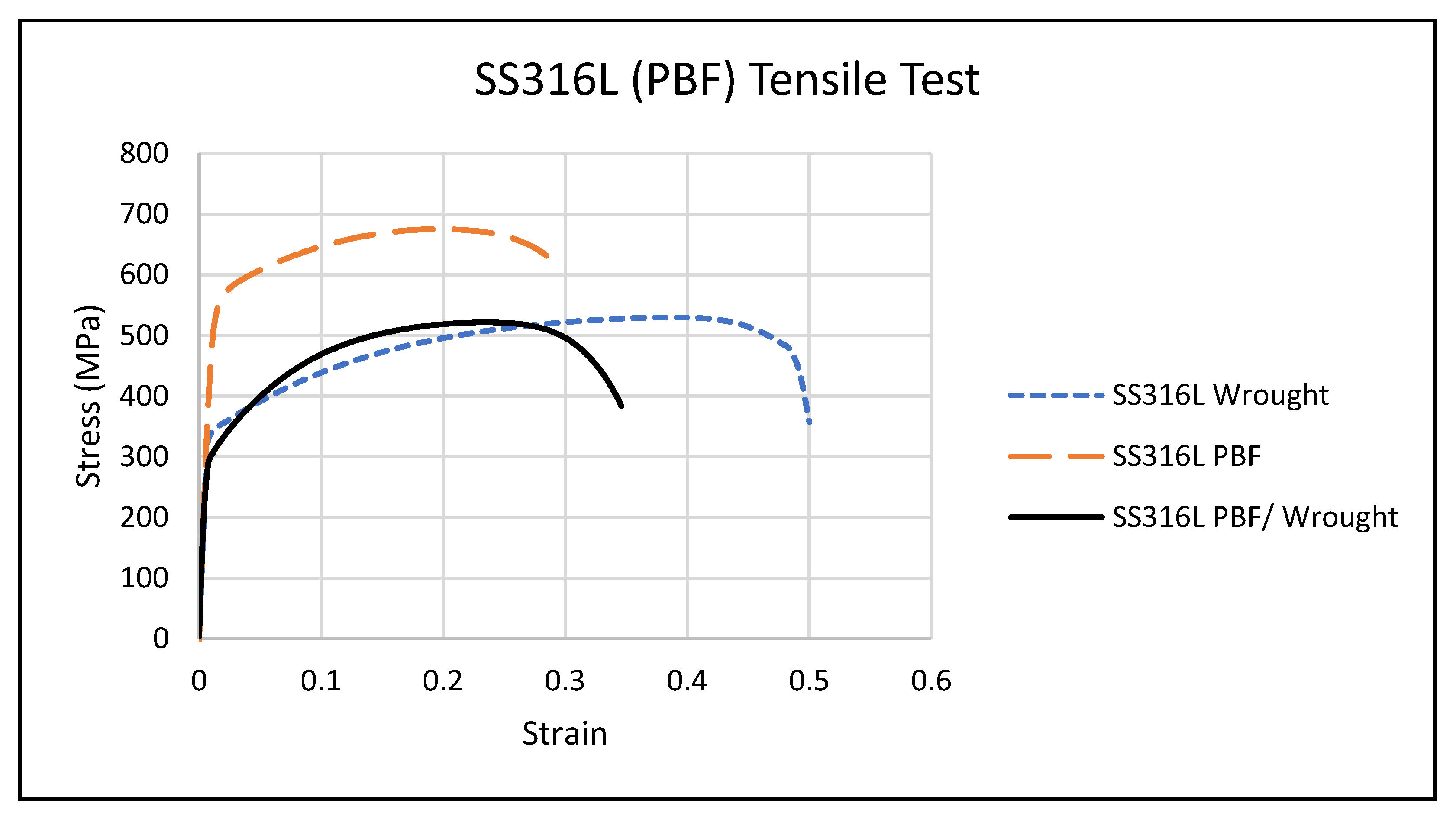

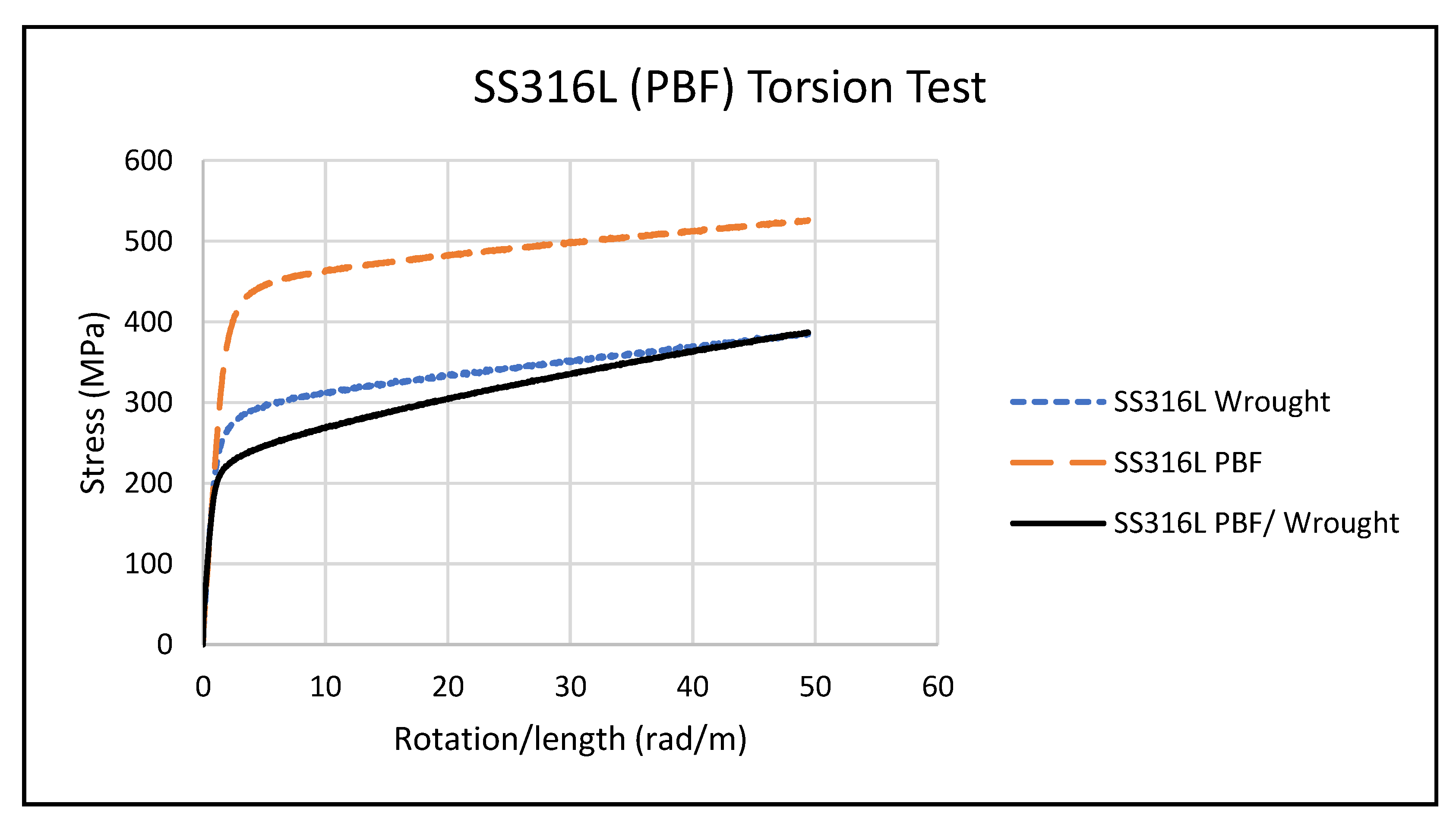

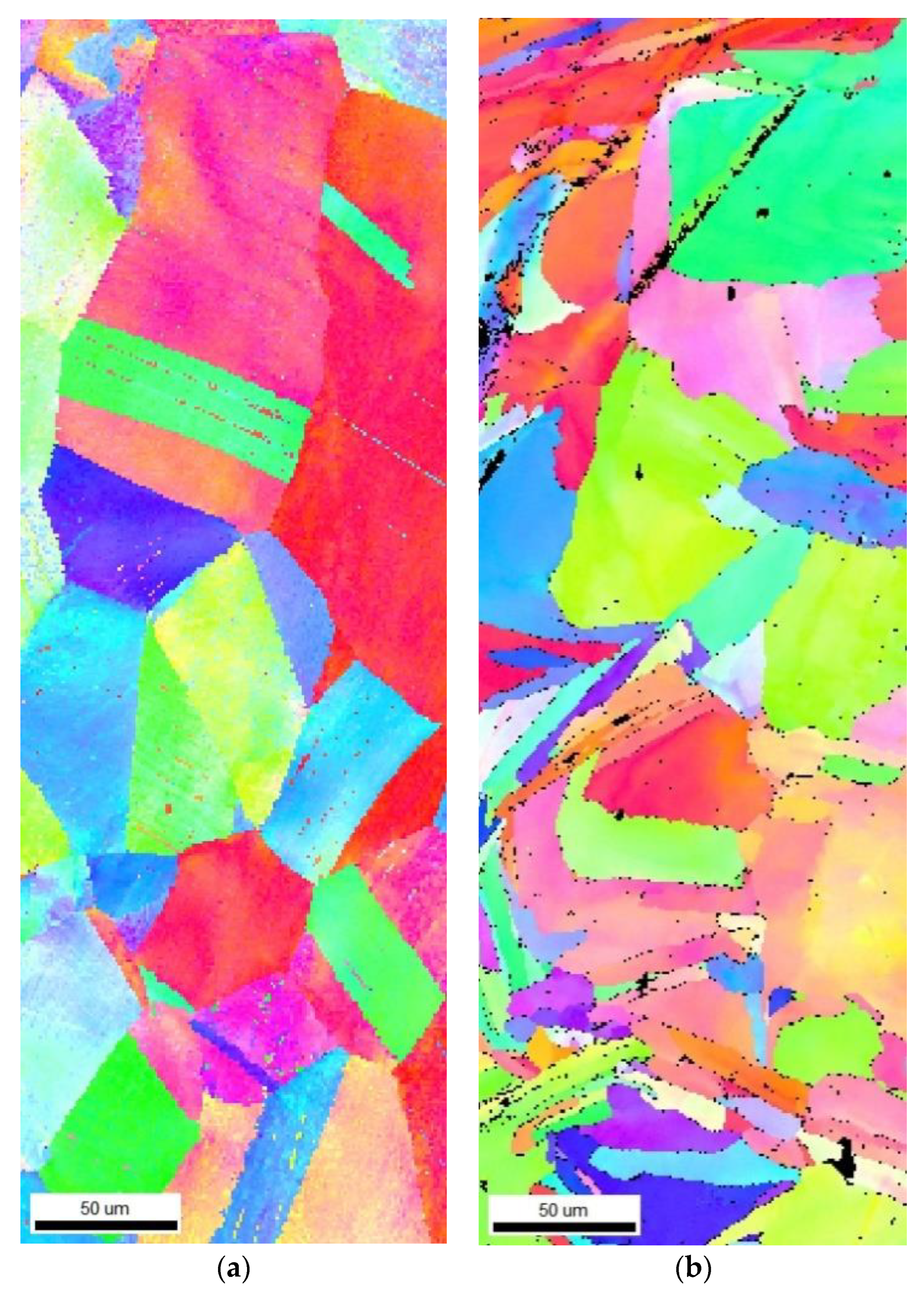
| SS316L Specimens | |||
|---|---|---|---|
| Wrought | PBF | PBF/Wrought | |
| Tension | 3 | 3 | 3 |
| Torsion | 2 1 | 3 | 3 |
| Microscopy | - | - | 1 |
| Wrought | PBF | PBF/Wrought | ASTM Min. [25] | Typical [26] | ||
|---|---|---|---|---|---|---|
| Mean | 320 MPa | 550 MPa | 300 MPa | 170 MPa | 300 MPa | |
| StdDev | 9.7 MPa | 2.4 MPa | 51 MPa | |||
| Mean | 530 MPa | 680 MPa | 520 MPa | 485 MPa | 585 MPa | |
| StdDev | 1.0 MPa | 2.6 MPa | 30 MPa |
| Comparison | Statistical Test (α = 0.05) | Different? (p ≤ 5.0 × 10−2) | |
|---|---|---|---|
| Among group | ANOVA | Yes (p = 4.7 × 10−4) | |
| Wrought vs. PBF | t-test (equal variance) | Yes (p = 3.1 × 10−5) | |
| Wrought vs. PBF/Wrought | t-test (equal variance) | No (p = 5.4 × 10−1) | |
| PBF vs. PBF/Wrought | t-test (uneq. variance) | Yes (p = 1.4 × 10−2) | |
| Among group | ANOVA | Yes (p = 3.1 × 10−4) | |
| Wrought vs. PBF | t-test (equal. variance) | Yes (p = 6.2 × 10−6) | |
| Wrought vs. PBF/Wrought | t-test (uneq. variance) | No (p = 6.3 × 10−1) | |
| PBF vs. PBF/Wrought | t-test (uneq. variance) | Yes (p = 1.2 × 10−2) |
| Wrought | PBF | PBF/Wrought | Typical [26] | ||
|---|---|---|---|---|---|
| Mean | 220 MPa | 380 MPa | 200 MPa | 180 MPa | |
| StdDev | 17 MPa | 4.6 MPa | 22 MPa | ||
| Mean | 71 GPa | 70 GPa | 61 GPa | 77 GPa | |
| StdDev | 3.7 GPa | 0.4 GPa | 5.5 GPa |
| Comparison | Statistical Test (α = 0.05) | Different? (p ≤ 5.0 × 10−2) | |
|---|---|---|---|
| Among group | ANOVA | Yes (p = 7.3 × 10−5) | |
| Wrought vs. PBF | t-test (equal variance) | Yes (p = 4.7 × 10−4) | |
| Wrought vs. PBF/Wrought | t-test (equal variance) | No (p = 4.3 × 10−1) | |
| PBF vs. PBF/Wrought | t-test (equal variance) | Yes (p = 5.0 × 10−3) | |
| Among group | ANOVA | Yes (p = 4.9 × 10−2) | |
| Wrought vs. PBF | t-test (uneq. variance) | No (p = 7.4 × 10−1) | |
| Wrought vs. PBF/Wrought | t-test (equal variance) | No (p = 1.1 × 10−1) | |
| PBF vs. PBF/Wrought | t-test (uneq. variance) | No (p = 1.0 × 10−1) |
| Number of Grains | Average Grain Size | St. Dev. of Grain Size | |
|---|---|---|---|
| Wrought | 288 | 60 µm | 13.64 µm |
| PBF | 225 | 48 µm | 14.31 µm |
Publisher’s Note: MDPI stays neutral with regard to jurisdictional claims in published maps and institutional affiliations. |
© 2021 by the authors. Licensee MDPI, Basel, Switzerland. This article is an open access article distributed under the terms and conditions of the Creative Commons Attribution (CC BY) license (https://creativecommons.org/licenses/by/4.0/).
Share and Cite
Weaver, J.M.; Linn, J.R.; Miles, M.P. Interface Joint Strength between SS316L Wrought Substrate and Powder Bed Fusion Built Parts. Materials 2021, 14, 3041. https://doi.org/10.3390/ma14113041
Weaver JM, Linn JR, Miles MP. Interface Joint Strength between SS316L Wrought Substrate and Powder Bed Fusion Built Parts. Materials. 2021; 14(11):3041. https://doi.org/10.3390/ma14113041
Chicago/Turabian StyleWeaver, Jason M., John R. Linn, and Michael P. Miles. 2021. "Interface Joint Strength between SS316L Wrought Substrate and Powder Bed Fusion Built Parts" Materials 14, no. 11: 3041. https://doi.org/10.3390/ma14113041






